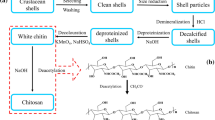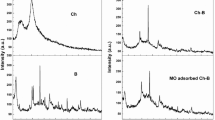Abstract
Cellulose acetate fibers were modified with a gelatin cryogel adsorbent incorporating an iron–carboxylate metal–organic framework and hypercrosslinked polymer composite. The hybrid adsorption materials facilitated the adsorption ability toward polycyclic aromatic hydrocarbons and were entrapped into gelatin cryogel to be hierarchically coated on cellulose acetate fibers which helped to reduce the clogging problem of packed adsorbent. The composite adsorbent was employed as the solid phase of an in-syringe miniaturized solid-phase extraction system. The adsorbent was packed into the needle hub of a disposable syringe and used to extract and preconcentrate polycyclic aromatic hydrocarbons in water sample. The fabricated porous composite adsorbent was characterized and extraction conditions were optimized to achieve the best extraction performance. High-performance liquid chromatography was employed to separate and quantify extracted PAHs. The developed analysis method provided a linear range of 0.020–50 µg L−1 for phenanthrene and benzo(b)fluoranthene, 0.010–50 µg L−1 for pyrene, 0.0020–50 µg L−1 for benzo(a)anthracene, and 0.0050–50 µg L−1 for benzo(a)pyrene and dibenzo(a,h)anthracene. The limits of detection ranged from 0.5 to 5.0 ng L−1. Recoveries ranged from 89 to 98% with RSDs below 7%. The good stability of the adsorbent allowed up to 21 cycles of efficient extraction and desorption.
Graphical abstract





Similar content being viewed by others
References
Alegbeleye OO, Opeolu BO, Jackson VA (2017) Polycyclic aromatic hydrocarbons: a critical review of environmental occurrence and bioremediation. Environ Manag 60:758–783. https://doi.org/10.1007/s00267-017-0896-2
Zhou Q, Wang Y, Xiao J, Fan H, Chen C (2019) Preparation and characterization of magnetic nanomaterial and its application for removal of polycyclic aromatic hydrocarbons. J Hazard Mater 371:323–331. https://doi.org/10.1016/j.jhazmat.2019.03.027
Asfaram A, Dil EA, Arabkhani P, Sadeghfar F, Ghaedi M (2020) Magnetic Cu: CuO-GO nanocomposite for efficient dispersive micro-solid phase extraction of polycyclic aromatic hydrocarbons from vegetable, fruit, and environmental water samples by liquid chromatographic determination. Talanta 218:121131. https://doi.org/10.1016/j.talanta.2020.121131
Yang X, Yin Y, Zong Y, Wan T, Liao X (2019) Magnetic nanocomposite as sorbent for magnetic solid phase extraction coupled with high performance liquid chromatography for determination of polycyclic aromatic hydrocarbons. Microchem J 145:26–34. https://doi.org/10.1016/j.microc.2018.10.013
Akvan N, Azimi G, Parastar H (2019) Chemometric assisted determination of 16 PAHs in water samples by ultrasonic assisted emulsification microextraction followed by fast high-performance liquid chromatography with diode array detector. Microchemical Journal 150:104056. https://doi.org/10.1016/j.microc.2019.104056
Amiri A, Ghaemi F, Maleki B (2019) Hybrid nanocomposites prepared from a metal-organic framework of type MOF-199(Cu) and graphene or fullerene as sorbents for dispersive solid phase extraction of polycyclic aromatic hydrocarbons. Microchimica Acta 186:131. https://doi.org/10.1007/s00604-019-3246-7
Yang X, Wang J, Wang W, Zhang S, Wang C, Zhou J, Wang Z (2019) Solid phase microextraction of polycyclic aromatic hydrocarbons by using an etched stainless-steel fiber coated with a covalent organic framework. Microchim Acta 186:145. https://doi.org/10.1007/s00604-019-3258-3
Soares da Silva Burato J, Vargas Medina DA, de Toffoli AL, Vasconcelos Soares Maciel E, Mauro Lanças F (2020) Recent advances and trends in miniaturized sample preparation techniques. J Separ Sci 43:202–225. https://doi.org/10.1002/jssc.201900776
AtirahMohdNazir N, Raoov M, Mohamad S (2020) Spent tea leaves as an adsorbent for micro-solid-phase extraction of polycyclic aromatic hydrocarbons (PAHs) from water and food samples prior to GC-FID analysis. Microchem J 159:105581. https://doi.org/10.1016/j.microc.2020.105581
Jillani SMS, Sajid M, Alhooshani K (2019) Evaluation of carbon foam as an adsorbent in stir-bar supported micro-solid-phase extraction coupled with gas chromatography–mass spectrometry for the determination of polyaromatic hydrocarbons in wastewater samples. Microchem J 144:361–368. https://doi.org/10.1016/j.microc.2018.09.027
Wang R, Chen Z (2017) A covalent organic framework-based magnetic sorbent for solid phase extraction of polycyclic aromatic hydrocarbons, and its hyphenation to HPLC for quantitation. Microchim Acta 184:3867–3874. https://doi.org/10.1007/s00604-017-2408-8
Azizi A, Shahhoseini F, Bottaro CS (2020) Magnetic molecularly imprinted polymers prepared by reversible addition fragmentation chain transfer polymerization for dispersive solid phase extraction of polycyclic aromatic hydrocarbons in water. J Chromatogr A 1610:460534. https://doi.org/10.1016/j.chroma.2019.460534
Li L, Han D, Wang M, Han Y, Yan H (2020) Molybdenum disulfide–hypercrosslinked polymer composite as an adsorbent for determination of polycyclic aromatic hydrocarbons in environmental water coupled with HPLC–FLD. Microchim Acta 187:242. https://doi.org/10.1007/s00604-020-4220-0
Shirani M, Salari F, Habibollahi S, Akbari A (2020) Needle hub in-syringe solid phase extraction based a novel functionalized biopolyamide for simultaneous green separation/preconcentration and determination of cobalt, nickel, and chromium (III) in food and environmental samples with micro sampling flame atomic absorption spectrometry. Microchem J 152:104340. https://doi.org/10.1016/j.microc.2019.104340
Tan S, Wang J, Han Q, Liang Q, Ding M (2018) A porous graphene sorbent coated with titanium(IV)-functionalized polydopamine for selective lab-in-syringe extraction of phosphoproteins and phosphopeptides. Microchim Acta 185:316. https://doi.org/10.1007/s00604-018-2846-y
Nurerk P, Bunkoed O, Jullakan S, Khongkla S, Llompart M, Poorahong S (2021) A dumbbell-shaped stir bar made from poly(3,4-ethylenedioxythiophene)-coated porous cryogel incorporating metal organic frameworks for the extraction of synthetic phenolic antioxidants in foodstuffs. J Chromatogr A 1655:462497. https://doi.org/10.1016/j.chroma.2021.462497
Ma J, Wu G, Li S, Tan W, Wang X, Li J, Chen L (2018) Magnetic solid-phase extraction of heterocyclic pesticides in environmental water samples using metal-organic frameworks coupled to high performance liquid chromatography determination. J Chromatogr A 1553:57–66. https://doi.org/10.1016/j.chroma.2018.04.034
Wang X, Ma X, Wang H, Huang P, Du X, Lu X (2017) A zinc(II) benzenetricarboxylate metal organic framework with unusual adsorption properties, and its application to the preconcentration of pesticides. Microchim Acta 184:3681–3687. https://doi.org/10.1007/s00604-017-2382-1
Huang S, Yang K-L, Liu X-F, Pan H, Zhang H, Yang S (2017) MIL-100(Fe)-catalyzed efficient conversion of hexoses to lactic acid. RSC Adv 7:5621–5627. https://doi.org/10.1039/C6RA26469G
Guo X-Z, Han S-S, Yang J-M, Wang X-M, Chen S-S, Quan S (2020) Effect of synergistic interplay between surface charge, crystalline defects, and pore volume of MIL-100(Fe) on adsorption of aqueous organic dyes. Industr Eng Chem Res 59:2113–2122. https://doi.org/10.1021/acs.iecr.9b05715
Detoni C, Gierlich CH, Rose M, Palkovits R (2014) Selective liquid phase adsorption of 5-hydroxymethylfurfural on nanoporous hyper-cross-linked polymers. ACS Sustain Chem Eng 2:2407–2415. https://doi.org/10.1021/sc5004264
Wang Y, Ma R, Xiao R, Hao L, Wu Q, Wang C, Wang Z (2018) A hyper-cross linked polymer as an adsorbent for the extraction of chlorophenols. Microchim Acta 185:108. https://doi.org/10.1007/s00604-017-2649-6
Liang X, Wang J, Wu Q, Wang C, Wang Z (2018) Use of a hypercrosslinked triphenylamine polymer as an efficient adsorbent for the enrichment of phenylurea herbicides. J Chromatogr A 1538:1–7. https://doi.org/10.1016/j.chroma.2018.01.033
Tolmacheva VV, Apyari VV, Furletov AA, Dmitrienko SG, Zolotov YA (2016) Facile synthesis of magnetic hypercrosslinked polystyrene and its application in the magnetic solid-phase extraction of sulfonamides from water and milk samples before their HPLC determination. Talanta 152:203–210. https://doi.org/10.1016/j.talanta.2016.02.010
Liu W, Wang J, Liu J, Hou F, Wu Q, Wang C, Wang Z (2020) Preparation of phenylboronic acid based hypercrosslinked polymers for effective adsorption of chlorophenols. J Chromatogr A 1628:461470. https://doi.org/10.1016/j.chroma.2020.461470
Nurerk P, Bunkoed W, Kanatharana P, Bunkoed O (2018) A miniaturized solid-phase extraction adsorbent of calix[4]arene-functionalized graphene oxide/polydopamine-coated cellulose acetate for the analysis of aflatoxins in corn. J Separ Sci 41:3892–3901. https://doi.org/10.1002/jssc.201800440
Milakin KA, Acharya U, Trchová M, Zasońska BA, Stejskal J (2020) Polypyrrole/gelatin cryogel as a precursor for a macroporous conducting polymer. React Funct Polym 157:104751. https://doi.org/10.1016/j.reactfunctpolym.2020.104751
Rattanakunsong N, Bunkoed O (2020) A porous composite monolith sorbent of polyaniline, multiwall carbon nanotubes and chitosan cryogel for aromatic compounds extraction. Microchem J 154:104562. https://doi.org/10.1016/j.microc.2019.104562
Lu Q, Zhang S, Xiong M, Lin F, Tang L, Huang B, Chen Y (2018) One-pot construction of cellulose-gelatin supramolecular hydrogels with high strength and pH-responsive properties. Carbohyd Polym 196:225–232. https://doi.org/10.1016/j.carbpol.2018.05.020
Li Y, Zhang L, Wu L, Sun S, Shan H, Wang Z (2018) Purification and enrichment of polycyclic aromatic hydrocarbons in environmental water samples by column clean-up coupled with continuous flow single drop microextraction. J Chromatogr A 1567:81–89. https://doi.org/10.1016/j.chroma.2018.07.013
Tong Y, Zhou Q, Sun Y, Sheng X, Zhou B, Zhao J, Guo J (2021) Magnetic polyamidoamine dendrimer grafted with 4-mercaptobenzoic acid as an adsorbent for preconcentration and sensitive determination of polycyclic aromatic hydrocarbons from environmental water samples. Talanta 224:121884. https://doi.org/10.1016/j.talanta.2020.121884
Zhang M, Huang G, Huang J, Chen W (2018) Three-dimensional multi-walled carbon nanotubes@g-C3N4@Fe3O4nanocomposites-based magnetic solid phase extraction for the determination of polycyclic aromatic hydrocarbons in water samples. Microchem J 142:385–393. https://doi.org/10.1016/j.microc.2018.04.016
Ncube S, Tavengwa N, Soqaka A, Cukrowska E, Chimuka L (2018) Development of a single format membrane assisted solvent extraction-molecularly imprinted polymer technique for extraction of polycyclic aromatic hydrocarbons in wastewater followed by gas chromatography mass spectrometry determination. J Chromatogr A 1569:36–43. https://doi.org/10.1016/j.chroma.2018.07.061
Acknowledgements
Suppawan Sillapawisut was supported by the Development and Promotion of Science and Technology Talents Project (DPST). The authors acknowledge the Research Institute for Health Science, Walailak University, for instrumental support. The authors also thank Mr. Thomas Duncan Coyne for English proofreading assistance.
Funding
This work was financially supported by Walailak University (Grant no. WU64242).
Author information
Authors and Affiliations
Corresponding author
Ethics declarations
Conflict of interest
The authors declare no competing interests.
Additional information
Publisher's note
Springer Nature remains neutral with regard to jurisdictional claims in published maps and institutional affiliations.
Supplementary Information
Below is the link to the electronic supplementary material.
Rights and permissions
About this article
Cite this article
Sillapawisut, S., Bunkoed, O., Llompart, M. et al. In-syringe solid-phase extraction of polycyclic aromatic hydrocarbons using an iron–carboxylate metal–organic framework and hypercrosslinked polymer composite gelatin cryogel–modified cellulose acetate adsorbent. Microchim Acta 189, 164 (2022). https://doi.org/10.1007/s00604-022-05276-8
Received:
Accepted:
Published:
DOI: https://doi.org/10.1007/s00604-022-05276-8




